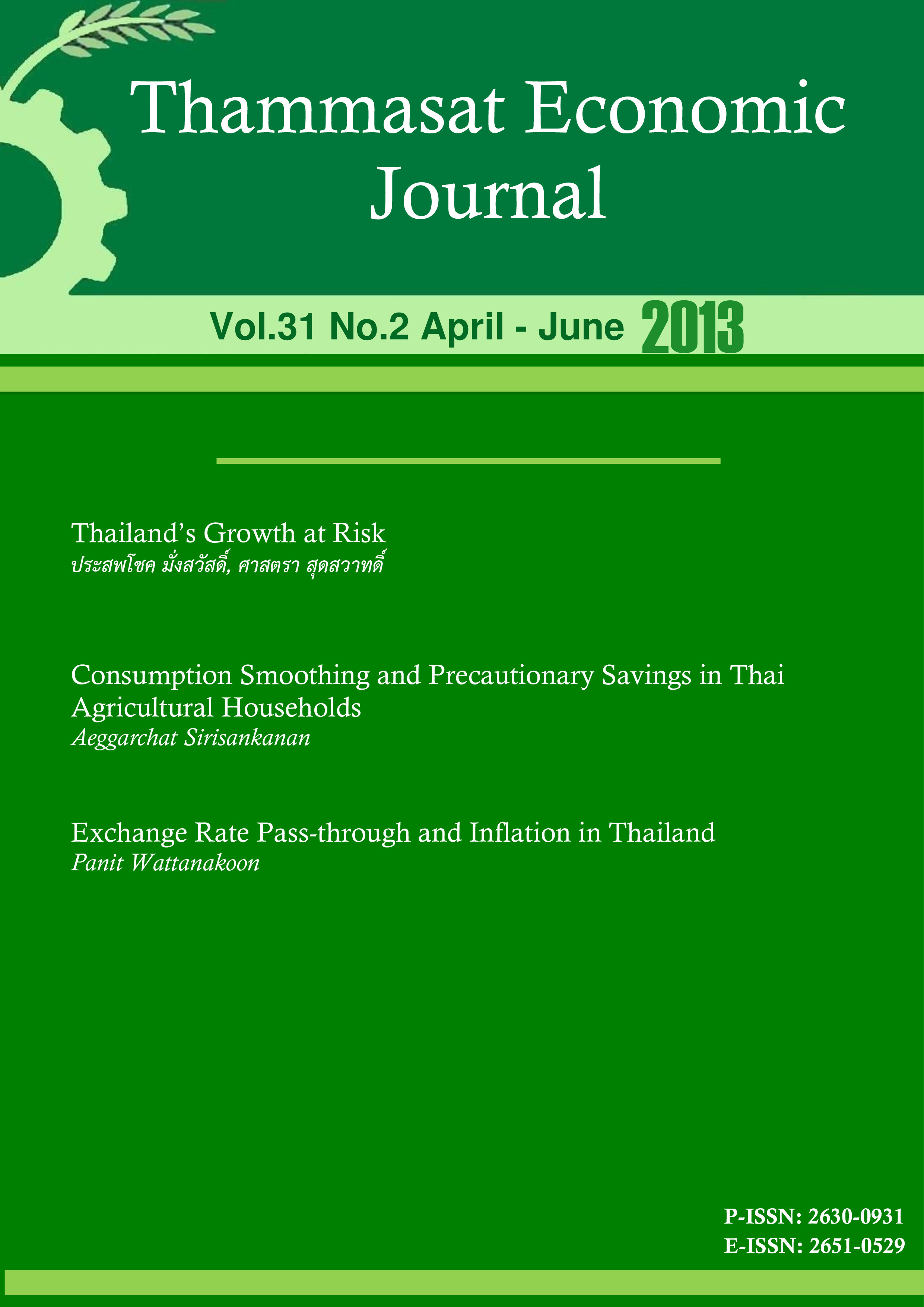Thailand’s Growth at Risk
Keywords:
Growth at risk, economic growth, downside riskAbstract
Growth at Risk (GaR), adapted from the Value at Risk concept, is a measurement of an expected maximum loss on growth over a target horizon within a given confidence interval. Based on the calculation of the GaR from the period of 1980 to 2009, Thailand risks the output loss of 7.88 percent during the big recessions. However, the number has climbed up to over 14 percent since the 1997 Asian financial crisis. For small recessions that occur in every four years, Thailand’s maximum economic loss is only 1.19 percent. According to the factor determinant analysis using the generalized method-of-moments (GMM) estimator, both external and internal factors play an important role on determining the GaR. The OECD GDP growth, the OECD unexpected GDP growth and the global liquidity are the important external risk factors, whilst the short-term external debt, the private credit and the current account are the crucial internal risk factors.
References
2.Barro, R. & Ursua, J. (2008) Macroeconomic Crises since 1870, NBER Working Paper no. 13940 (National Bureau of Economic Research: Cambridge, MA).
3.Bernanke, B. & Gertler, M. (1995) Inside the Black Box: The Credit Channel of Monetary PolicyTransmission, Journal of Economic Perspectives, Vol. 9, pp. 27–48.
4.Bernanke, B., Gertler, M. & Gilchrist, S. (1996) The Financial Accelerator and the Flight to Quality, Review of Economics and Statistics, Vol.78, pp. 1–15.
5.Blanchard, O., J. Das, M., & Faruqee, H. (2010) The Initial Impact of the Crisis on Emerging Market Countries, Brookings Papers on Economic Activity, pp. 263-307.
6.Easterly, W. (2001) The Lost Decades: Developing Countries’ Stagnation in Spite of Policy Reform1980, Journal of Economic Growth, Vol. 6, pp. 135-157.
7.Easterly, W., Islam, R., & Stiglitz, J. E. (2000) Explaining Growth Volatility, World Bank Working Paper 04/13/00 (World Bank).
8.Eichengreen, B., Park, D., & Shin, K. (2011) When Fast Growing Economies Slow Down: International Evidence and Implications for China, NBER Working Paper no. 16919 (National Bureau of Economic Research: Cambridge, MA).
9.Evan, G., Honkapohja, S. & Romer, P. (1996) Growth Cycle, American Economic Review, Vol. 88, pp. 495-515.
10.Hall, J. (2009) Options, Futures, and Other Derivatives (New Jersey: Pearson Prentice Hall).
11.Hansen, L. P. (1982) Large Sample Properties of Generalized Method of Moments Estimators, Econometrica, Vol. 56, pp. 1029–1054.
12.Hausmann, R., Pritchett, L., & Rodrik, D. (2005) Growth Accelerations, Journal of Economic Growth, Vol. 10, pp. 303-329.
13.Jorion, P. (2007) Value at Risk (New York: McGraw Hill).
14.Wang, Y. & Yao, Y. (2007) Measuring Downside Risk and Severity for Global Output, Journal of Forecasting, Vol. 26, pp. 23-32.
15.Wang, Y. &Yao, Y. (2001) Measuring Economic Downside Risk and Severity: Growth at Risk, World Bank Policy Paper 2674 (World Bank).










